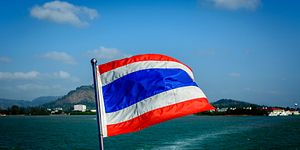Thailand should brace for serious water shortages when the hot season begins in March after a year with unusually little rainfall, one of the country’s top water management officials said earlier this week.
Retention of water by dams in upstream areas of the Mekong River also is seen as contributing to record-low water levels in the river, affecting the region’s ecology.
Somkiat Prajumwong, director-general of Thailand’s Office of National Water Resources, said Monday that the river will experience record-low levels, after already recording new records this past year.
His agency is warning people along the Mekong to beware of river bank slides and prepare for serious water shortages in March and April, when temperatures in Thailand usually peak.
Tests of China’s new upstream Jinghong dam on Jan. 1-3 are expected to lead to a drop in the the Mekong’s water level by as much as 1 meter (3.3 feet) along eight northern and northeastern Thai provinces, said the water resources agency.
Restrictions on water use from some Thai dams were imposed by late December, according to a report in the Bangkok Post. It quoted the head of Thailand’s Royal Irrigation Department, Thongplew Kongjun, as saying that water from the Ubol Ratana and Chulabhorn dams was being reserved for consumption and ecological conservation, rather than for growing crops, because of their low levels.
The Mekong River Commission already warned that severe to extreme drought was expected to hit Thailand and Cambodia at least until January. The regional agency, to which Laos and Vietnam also belong, blamed insufficient wet season rainfall, an abbreviated period of monsoon rains and unusually high temperatures and evaporation caused by El Nino, a cyclical climate phenomenon originating with warming water in the Pacific Ocean.
The commission said in a paper issued at its annual meeting in November that the long-term prognosis was bleak, as the Lower Mekong Basin for the past few decades “has been experiencing severe drought hazards with serious economic losses due to damages of agricultural crops, negative impacts on the environment, and effects on people’s livelihoods.”
“The duration and magnitude of the impacts have significantly increased over the past two decades if comparing the drought hazards from one event to another,” it said.
It warned that, depending upon factors involving the climate, the lower Mekong basin “is likely to see more severe droughts in the next 30, 60 and 90 years due to less precipitation, high air temperature,” as well a high percentage of evaporation from ground and plants.
The issue involving dams was vividly illustrated about a month ago, when the Mekong River acquired an aquamarine color due to the water becoming clear and reflecting the sky, replacing its usual yellowish-brown shade that is due to the sediment it normally carries downstream.
Experts blamed the large Xayaburi hydroelectric dam upstream in Laos that began operating in October for causing the color change.
The dam blocks much sediment from moving farther downstream, which accounts for the water becoming clear, Pravit Kanthaduang, a fishery official in Thailand’s Bueng Kan province, said earlier this month. Less sediment means less nutrition for plants and fish in the river, threatening the ecological balance, he said.
“The current has less sediment, which unleashes energy onto the river banks downstream,” said Chainarong Setthachau of the Faculty of Humanities and Social Science at Thailand’s Mahasarakham University. “This so-called ‘hungry water’ will cause much more erosion to the banks, uprooting trees and damaging engineering structures in the river.”
The dam’s developers said they spent more than 19.4 billion baht ($648 million) to mitigate negative impacts on the environment.
Environmental activists have expressed urgent concern about the upstream dams.
“Thai riverine communities living along the Mekong, downstream of dams in China and Xayaburi dam in Laos, have never experienced ecological changes at this scale,” Pianporn Deetes of the conservation group International Rivers said Monday. “Amidst drought, dams exacerbate the destruction of the Mekong’s fragile ecosystem, especially for unseasonal water fluctuation that means impacts on aquatic lives, fisheries, food and income security, water supply, navigation and more.”
As reported by Grant Peck of the Associated Press.

































